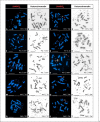With or Without W? Molecular and Cytogenetic Markers are Not Sufficient for Identification of Environmentally-Induced Sex Reversal in the Bearded Dragon
- PMID: 33756476
- PMCID: PMC8491511
- DOI: 10.1159/000514195
With or Without W? Molecular and Cytogenetic Markers are Not Sufficient for Identification of Environmentally-Induced Sex Reversal in the Bearded Dragon
Erratum in
-
Erratum.Sex Dev. 2021;15(4):282-285. doi: 10.1159/000517966. Epub 2021 Jul 30. Sex Dev. 2021. PMID: 34350896 Free PMC article. No abstract available.
Abstract
Transitions from environmental sex determination (ESD) to genotypic sex determination (GSD) require an intermediate step of sex reversal, i.e., the production of individuals with a mismatch between the ancestral genotypic and the phenotypic sex. Among amniotes, the sole well-documented transition in this direction was shown in the laboratory in the central bearded dragon, Pogona vitticeps, where very high incubation temperatures led to the production of females with the male-typical (ZZ) genotype. These sex-reversed females then produced offspring whose sex depended on the incubation temperature. Sex-reversed animals identified by molecular and cytogenetic markers were also reported in the field, and their increasing incidence was speculated as a climate warming-driven transition in sex determination. We show that the molecular and cytogenetic markers normally sex-linked in P. vitticeps are also sex-linked in P. henrylawsoni and P. minor, which points to quite ancient sex chromosomes in this lineage. Nevertheless, we demonstrate, based on a crossing experiment with a male bearded dragon who possesses a mismatch between phenotypic sex and genotype, that the used cytogenetic and molecular markers might not be reliable for the identification of sex reversal. Sex reversal should not be considered as the only mechanism causing a mismatch between genetic sex-linked markers and phenotypic sex, which can emerge also by other processes, here most likely by a rare recombination between regions of sex chromosomes which are normally sex-linked. We warn that sex-linked, even apparently for a long evolutionary time, and sex-specific molecular and cytogenetic markers are not a reliable tool for the identification of sex-reversed individuals in a population and that sex reversal has to be verified by other approaches, particularly by observation of the sex ratio of the progeny.
Keywords: Molecular markers; Reversal; Sex chromosomes; Sex linkage; Vertebrates.
© 2021 The Author(s) Published by S. Karger AG, Basel.
Conflict of interest statement
We declare no competing interests in relation to the work.
Figures



Comment in
-
Concerning an Article by Ehl et al.: False Premise Leads to False Conclusions.Sex Dev. 2021;15(4):286-288. doi: 10.1159/000518374. Epub 2021 Jul 29. Sex Dev. 2021. PMID: 34350888 No abstract available.
Similar articles
-
Evolutionary stability inferred for a free ranging lizard with sex-reversal.Mol Ecol. 2022 Apr;31(8):2281-2292. doi: 10.1111/mec.16404. Epub 2022 Feb 27. Mol Ecol. 2022. PMID: 35178809 Free PMC article.
-
Sex reversal triggers the rapid transition from genetic to temperature-dependent sex.Nature. 2015 Jul 2;523(7558):79-82. doi: 10.1038/nature14574. Nature. 2015. PMID: 26135451
-
ZW Sex Chromosomes in Australian Dragon Lizards (Agamidae) Originated from a Combination of Duplication and Translocation in the Nucleolar Organising Region.Genes (Basel). 2019 Oct 30;10(11):861. doi: 10.3390/genes10110861. Genes (Basel). 2019. PMID: 31671601 Free PMC article.
-
Temperature-Induced Sex Reversal in Reptiles: Prevalence, Discovery, and Evolutionary Implications.Sex Dev. 2021;15(1-3):148-156. doi: 10.1159/000515687. Epub 2021 Jun 10. Sex Dev. 2021. PMID: 34111872 Review.
-
What was the ancestral sex-determining mechanism in amniote vertebrates?Biol Rev Camb Philos Soc. 2016 Feb;91(1):1-12. doi: 10.1111/brv.12156. Epub 2014 Nov 25. Biol Rev Camb Philos Soc. 2016. PMID: 25424152 Review.
Cited by
-
Sex chromosome evolution among amniotes: is the origin of sex chromosomes non-random?Philos Trans R Soc Lond B Biol Sci. 2021 Sep 13;376(1833):20200108. doi: 10.1098/rstb.2020.0108. Epub 2021 Jul 26. Philos Trans R Soc Lond B Biol Sci. 2021. PMID: 34304592 Free PMC article.
-
Expanding the classical paradigm: what we have learnt from vertebrates about sex chromosome evolution.Philos Trans R Soc Lond B Biol Sci. 2021 Sep 13;376(1833):20200097. doi: 10.1098/rstb.2020.0097. Epub 2021 Jul 26. Philos Trans R Soc Lond B Biol Sci. 2021. PMID: 34304593 Free PMC article. Review.
References
-
- Altmanová M, Rovatsos M, Kratochvíl L, Johnson Pokorná M. Minute Y chromosomes and karyotype evolution in Madagascan iguanas (Squamata: Iguania: Opluridae) Biol J Linn Soc. 2016;118((3)):618–33.
-
- Altmanová M, Rovatsos M, Johnson Pokorná M, Veselý M, Wagner F, Kratochvíl L. All iguana families with the exception of basilisks share sex chromosomes. Zoology. 2018;126:98–102. - PubMed
-
- Altschul SF, Gish W, Miller W, Myers EW, Lipman DJ. Basic local alignment search tool. J Mol Biol. 1990;215((3)):403–10. - PubMed
-
- Castelli MA, Georges A, Cherryh C, Rosauer DF, Sarre SS, Contador‐Kelsall I, et al. Evolving thermal thresholds explain the distribution of temperature sex reversal in an Australian dragon lizard. Divers Distrib. 2020 ..in press.
Publication types
MeSH terms
LinkOut - more resources
Full Text Sources
Other Literature Sources
Miscellaneous

